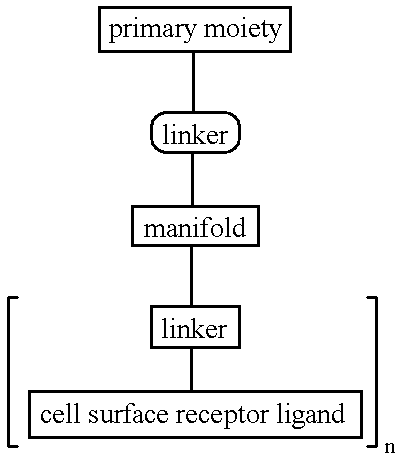Targeted oligonucleotide conjugates
a technology of oligonucleotide and conjugate, which is applied in the field of targeted oligonucleotide conjugates, can solve the problems of high systemic toxicity, the method of treatment does not distinguish between diseased cells and healthy ones, and the delivery system of oligonucleotide is good for in vitro cell systems
- Summary
- Abstract
- Description
- Claims
- Application Information
AI Technical Summary
Benefits of technology
Problems solved by technology
Method used
Image
Examples
example 2
[0067] Synthesis of .alpha.-D-lactosyl Acid Bromide
[0068] Following the procedures illustrated for Example 1 above, dry D-lactose was transformed to octaacetylated D-lactose, which was obtained as a 20:80 mixture of .alpha. / .beta.-anomers (.alpha.-anomer: doublet, 6.19 ppm, JH.sub.H1'-H2'=3.7 Hz, H1'; .beta.-anomer: doublet, 5.1 ppm, JH.sub.H1'-H2'=8.4 Hz, H1') in 76% yield. The octaacetate was used without further purification by treatment with a solution of HBr (5 molar eq., 30% solution in glacial acetic acid). After the lactosyl compound dissolved (.about.4-5 min.), the HBr and the acetic acid were quickly removed to avoid hydrolysis of the .beta.(1-4) -.largecircle.-glycosidic linkage. The title compound was obtained as a thick brown oil in 97% yield. The title compound was used without further purification in the next step.
example 3
[0069] Synthesis of Peracetylated-.beta.-azidogalactose
[0070] 2,3,4,5-Aceto-1-bromo-.alpha.-D-galactose was reacted under phase transfer catalysis (PTC) conditions previously reported (Tropper et al., Ph.D Thesis, University of Ottawa, 1992.) with 5 eq. of sodium azide in the presence of tetrabutylammonium hydrogen sulfate (PTS) (1 eq.) in a 1:1 mixture of CH.sub.2Cl.sub.2 and NaHCO.sub.3 (saturated solution). After 3 hours, under vigorous stirring, the title compound was obtained as a pale yellow solid in 97% yield. The characteristic .sup.1H-NMR [anomeric .alpha.-H; 4.56 ppm (.sup.3JH.sub.H1'-H2'=8.6 Hz)] and .sup.13C-NMR [anomeric C-1'; 88.29 ppm] data confirmed the structure and was in agreement with published data. This reaction occurred with complete inversion (.sup.3JH.sub.H1'-H2'=8.6 Hz confirmed the 1,2-trans-.beta.-D-anomeric configuration) and therefore established the desired stereochemistry.
example 4
[0071] Peracetylated-.beta.-azidolactose
[0072] Following the procedures illustrated for Example 1 above, .alpha.-D-lactosyl acid bromide was converted to the .beta.-azidolactose. The title compound was obtained as a pale orange oil in 92% yield. The characteristic .sup.1H-NMR [glucose anomeric .alpha.-H; 4.6 ppm (.sup.3J.sub.H1'-H2'=8.8 Hz)] and .sup.13C-NMR [glucose anomeric C-1'; 88.30 ppm] data confirmed the structure and was in agreement with published data (Tropper et al., Synthesis, 1992, 7, 618). The PTC reaction occurred with complete inversion as observed for the peracetylated-.beta.-azidogalactose.
PUM
| Property | Measurement | Unit |
|---|---|---|
| length | aaaaa | aaaaa |
| length | aaaaa | aaaaa |
| temperature | aaaaa | aaaaa |
Abstract
Description
Claims
Application Information
 Login to View More
Login to View More - R&D
- Intellectual Property
- Life Sciences
- Materials
- Tech Scout
- Unparalleled Data Quality
- Higher Quality Content
- 60% Fewer Hallucinations
Browse by: Latest US Patents, China's latest patents, Technical Efficacy Thesaurus, Application Domain, Technology Topic, Popular Technical Reports.
© 2025 PatSnap. All rights reserved.Legal|Privacy policy|Modern Slavery Act Transparency Statement|Sitemap|About US| Contact US: help@patsnap.com



